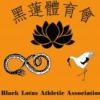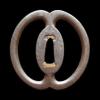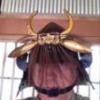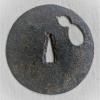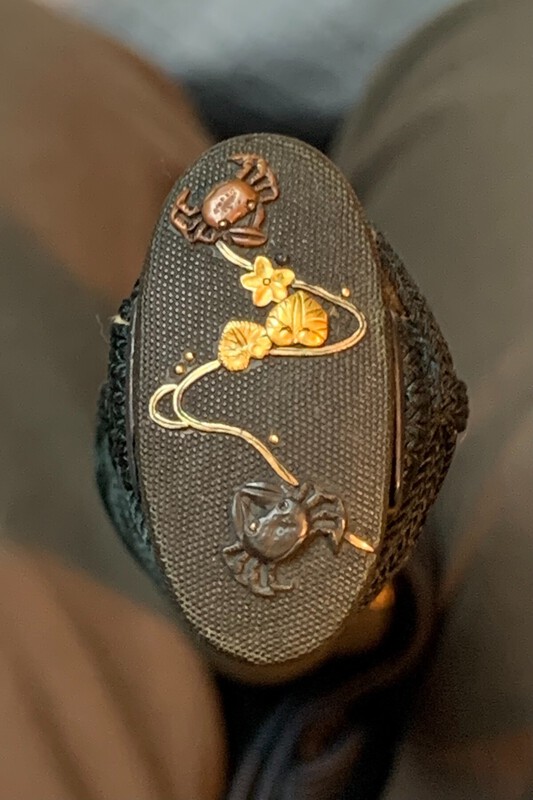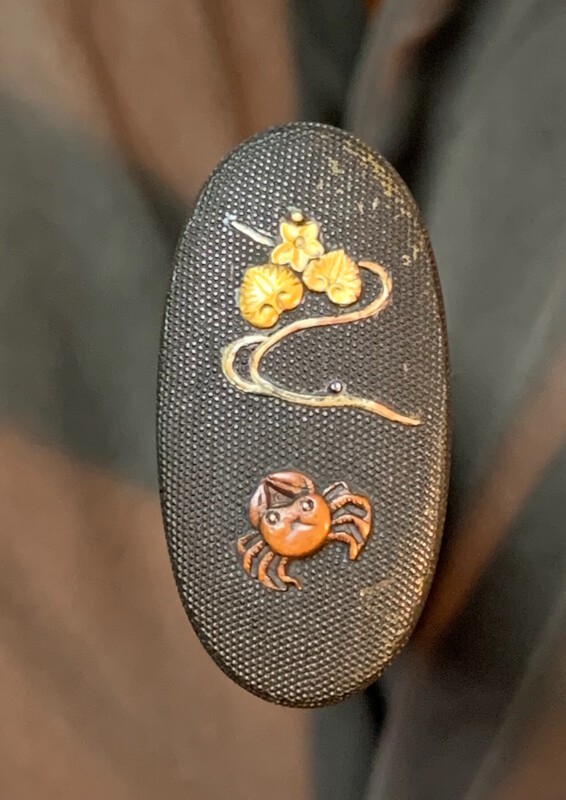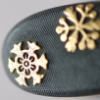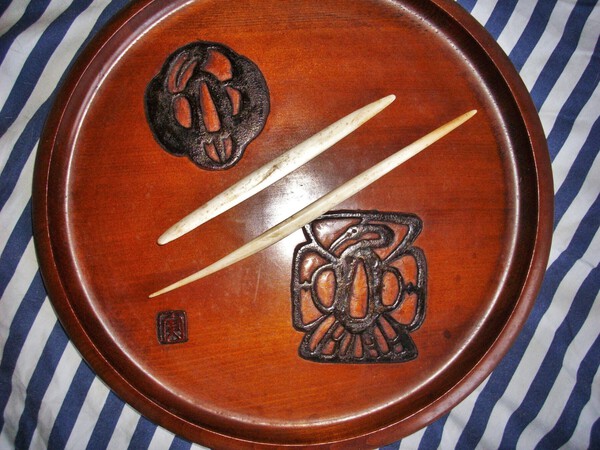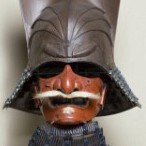Leaderboard
Popular Content
Showing content with the highest reputation on 12/25/2021 in all areas
-
11 points
-
I guess that the katana is a military sword during WWII. I can only read 百(100), 一(1), and 年(year) for sure from the date inscription on the nakago. But they suggest that the date may be 2601 of Imperial year (--> 1941).2 points
-
2 points
-
Thank you for all of the helpful information. This gives me so much context, I'll be spending much time diving further into this gun's history. I'll update the thread if I can replace the missing components. Looking forward to posting the next one I find!2 points
-
There is no way how any substance could penetrate into the steel. Usually, steel has a very compact structure; it is not a sponge. This may be a bit different in case of cracks and fissures, but these are not part of the molecular structure. There are no pores in the steel.2 points
-
Item No. 176 Kozuka in Copper with gold and shakudo details. Subject of two immortals - the Taoist sage Laozi ( Roshi ) and Tekkai Sennin . Signed on reverse Hamano Naoyuki and kao. Roshi is reading a scroll and wearing a robe. Both characters have teeth and eyes detailed in gold , while Tekkai Sennin has a staff shown in shakudo. Some fine work on this piece. Item No. 177 Tsuba in Iron with lead plugs 8.82 cm x 8.37 cm x 0.40 cm Tsuba with morning glory, wheel, and hexagonal patterns engraved . Myochin Nobuie ? Early to Mid 19th cent. ? Heavy piece showing some evidence of mounting and wear - could this be earlier than 19th cent. ?2 points
-
2 points
-
First batch: $40 dollars each + shipping -7" by 2.5" -foam insert will prevent swords from sagging and hitting surfaces (or other swords on same pillow) -simple design doesn't distract from the steel -slightly thicker than most makura to make picking up and setting down swords easier -fabric won't deform or bunch up -hand sewn by me Colors available: 1-Green 3-Navy 1-Black1 point
-
1 point
-
1 point
-
Six yes only 6 hours to go bidders. Can we make $700. 😁1 point
-
That problem is easily solved. I will throw my useless and expensive KIRI wood TSUBAKO in the bin and store my TSUBA in a wide-necked glass container filled with oil!1 point
-
Reading the ‘iron Tsuba - cleaning’ thread, I thought I’d play around with the larger of these two here and see what happens. If there’s any improvement at all, I’ll post the result.1 point
-
Personal opinion only, the sword has been meddled with quite some. The nakago seems acid damaged (like someone tried really hard to artificial age it) then there is the chance the yasurime were added aggressively before that and an old mei removed for a gimei. Nakago looks shinshinto or later ( forgive me for not being able to read mei, yet) As said, it's your money , depends on the threshold and why you want it or what you hope you will gain from it1 point
-
All I can say is be patient. There are some series that have only one blade reported. It is important to have clear pictures of the serial numbers just for the reason you give. Many of the katakana can be confused with other katakana characters. While by no means a complete list, below are some examples that can be confused one with another. ホネ チテ ヌスヲラ ワウフ タクケ ノソツシ コユ エヱ And finally, it is that time of year to give a big "Thank You" to all that have contributed a Mantetsu or two to the database. Without you, there would be nothing to work with. A special thanks to Bruce for putting it all together for all to enjoy!1 point
-
I hate to provide an answer to this as it is certainly debatable and there are always opposing views. First, let me say that oiling a nakago is not the same as cleaning it. Opposing views exist on this as well. You asked about the chemistry involved when boiling a tsuba, here it is: Boiling produces endothermic reaction which converts rust (Hematite fe2 03) to mill scale (Magnetite fe3 04). My opinion and that is all it is, my opinion, is that boiling may remove some of the "stuff" inside the sukashi. Which is why I will reiterate: The best advice for most tsuba is, leave them be. I have only boiled a few and only when I found it absolutely necessary in order to preserve the tsuba. I personally prefer to send any tsuba I feel needs this amount of preservation to a pro like Brian T. As far as eating away the inside of the sukashi. Like the outside, the inside has a good patination layer on it and was most likely oiled, waxed or lacquered at the time it was made, which helps to protect it. No amount of patination or protective coating can withstand hard use, severe abuse and/or long term exposure to the elements without some degradation. This is why we see the occasional tsuba with severe rust damage or complete deterioration to the thin sukashi elements and as well as the rim or seppa dai. On the other hand you see the majority of tsuba which are completely intact with minimal or no damage. Others which were cherished and meticulously cared for may be several hundred years old and yet are pristine. Hope this helps. Ed1 point
-
Just a quick post to send Season's Greetings to all contributors to and viewers of this thread. Can't believe it's been ten months since we started . Lots more to come ! Best Regards to all. Bob1 point
-
1 point
-
1 point
-
Thanks to Grev (Kissakai) for this beauty. I will be the envy of the Iaido Club in the new year. I have bought many items from Grev in the past and he is a scholar and a gentleman.1 point
-
1 point
-
1 point
-
Well, we had our gunsmiths go at it, and they got it out relatively easily without any damage. Tang is signed 角秀國. The blade is 27 1/2 inches long (38 1/4 inches overall), and it has a very interesting profile It has a Yokote in the polish, but I'm not sure if there is actually a kissaki. I feel no difference in the taper, and the Yokote is about 3 inches from the tip. It almost looks like a Shobu Zukiri. I don't have time right now to take more photos and measurements, but I'll be sure to post them when I can. https://nihontoclub.com/smiths/HID601 point
-
Wow. I'm humbled. Thanks Stephen, who has bailed me out more times than I can count. Wishing you a WONDERFUL Festive Season and to all on the NMB. Brian1 point
-
yes, why would anyone trust you with their items if you refuse to even provide name / fees/ information?1 point
-
I don't know if I'm interested without some more information. Why do you want to keep everything obscured and waste time covering these things privately in PM?1 point
-
There is an interesting article on cleaning Iron guards here: http://www.japaneseswordindex.com/tsuba/tsubacln.htm I am not sure I would agree with "NEVER clean the inside of the sukashi". One of mine had a piece of rock wedged in a cavity that obviously wasn't there as decoration and other greasy objects that blocked up other undercutting - I can't see the retention of this adding any cultural or aesthetic value.1 point
-
1 point
-
1 point
-
If you are going to boil them, be sure that you use deionized (distilled) water. "Hard" water has a lot of minerals in it.1 point
-
Pippo: Never, never use steel wool - no matter how fine it will destroy any and all patina. The best thing to use is either Ivory, bone or antler to rub the active rust off, it won't damage the iron surface but readily removes the softer rust. You can buy bone or ivory awls on-line but they are expensive, if you can find a ruined old piano key they can be used if they are ivory. I make my own bone picks from cow long leg bones, boil them for a few minutes and dry them, then cut into pencil size pieces. I use a bench grinder to smooth and shape. Simply boiling the iron guard in clean water can also remove a lot of accumulated dirt and softens the rust - just make sure you dry the guard carefully afterward. You might use a soft brush or even a tooth brush to remove the dust generated when you use the bone tools, just nothing harder than soft bristles.1 point
-
0 points
-
Chris, I don't understand. How did that fit into your stocking? Well, on the other side quite nice! Congratulations!0 points
-
Oh wow. Never seen anything like before. Maybe the smith was frighten by a bomber raid as he worked on forming the yakiba with clay? A very unique sword.0 points
-
0 points
This leaderboard is set to Johannesburg/GMT+02:00

